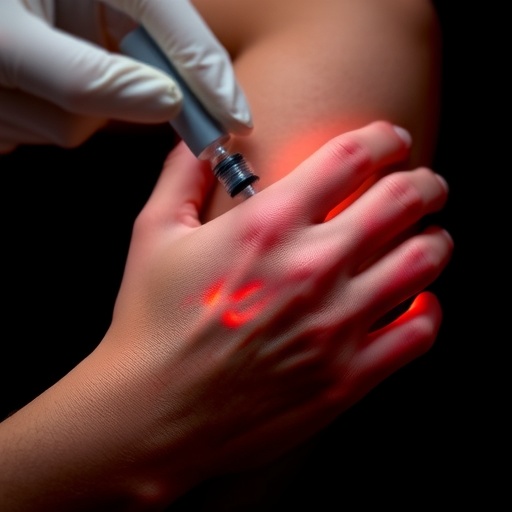Researchers have ventured into the promising realm of regenerative medicine, pioneering an innovative technique characterized as “skin in a syringe.” Grounded in the formidable collaboration between experts in regenerative medicine and materials science, this groundbreaking research unveils a gel embedding living cells that has the remarkable potential to be 3D printed into feasible skin transplants. The veracity of this research is encapsulated in the findings published in the esteemed journal Advanced Healthcare Materials.
The approach addresses a dire need in medical treatment for extensive burns and severe wounds, allowing for the restoration of the skin barrier, which is often essential for survival. Historically, the treatment for large burns involved transplanting a thin epithelial layer from the skin, a process that predominantly utilizes a single type of cell, which unfortunately results in significant scar formation. This method overlooks the complexity of skin structure, comprising two vital layers: the epidermis, which is the outermost layer, and the dermis, which lies beneath it. The dermis is pivotal for skin functionality; it possesses nerve endings, blood vessels, hair follicles, and various other critical structures.
Conventional surgical options that aim to repair tissue damage often lead to additional wounds because the dermis is rarely transplantable due to its complexity. The surgical process of accessing and harvesting dermis to rectify a host’s injury leaves behind a substantial wound, conflicting with the objective of effective healing. Researchers, however, have turned the focus toward generating a new form of skin that does not merely become scar tissue but rather matures into a functioning construct.
Within this innovative framework, the most common cell type present in the dermis, the fibroblast, emerges as a prominent candidate for lab cultivation. Fibroblasts are crucial as they can evolve into more specialized cell types as dictated by the healing needs of the tissue. To aid in this transformation, scientists have designed a scaffold that allows these cells to develop upon tiny, porous beads of gelatin, a synthetic substance reminiscent of the collagen found in human skin. However, practical applications of this scaffolding present immediate challenges, particularly in ensuring stability when directly applied to a wound.
The research team resolved this issue by devising a method that harmonizes gelatin beads with a body-specific gel composed of hyaluronic acid. The coalescence of these two materials is deftly executed through an approach called click chemistry, yielding a unique gel composition that resembles “skin in a syringe.” This gel’s notable feature allows it to transform from a liquid state to a gel-like form when subjected to pressure, facilitating its application via a syringe. Once injected, this technology offers the novel capability of 3D printing with live cells embedded in the gel.
The preliminary animal studies conducted involved 3D-printing small pucks of this innovative material, which were subsequently implanted beneath the skin of live mice. Initial results reveal promising indicators, as researchers observed the survival of the cells and their production of essential substances that contribute to dermal formation. More compelling is the formation of blood vessels within the graft material, a crucial aspect that is vital for the longevity and functionality of transplanted tissues in a living organism.
Blood vessel development is a pivotal consideration not just in skin regeneration but in a multitude of engineered tissue applications. One significant limitation within the current framework of engineered tissues resides in their capacity to sustain themselves, as living structures often lack the necessary vascular systems to transport oxygen and nutrients to cells located deep within. This deficiency imposes strict limitations on the size and complexity that tissue constructs can achieve before central cells succumb to anoxic conditions.
Significantly, the researchers at Linköping University are making strides toward addressing this vascular supply conundrum. In a concomitant publication, they detail an innovative methodology for crafting threads formulated from hydrogels, which consist predominantly of water—up to 98%. These hydrogel threads exhibit remarkable elasticity, enabling manipulation through knots and other physical constructs. Furthermore, they can be shaped into mini-tubes, which hold remarkable potential for facilitating fluid transport or supporting the growth of vasculature cells.
These mini-tubes or perfusable channels develop new vistas for organoid development and blood vessel engineering, representing a forward leap in regenerative medicine. As the research progresses, the implications of such advancements could translate into real-world applications, enhancing the scope and effectiveness of tissue engineering whilst addressing some of the long-standing challenges associated with viability and functional integration in complex tissue systems.
The study, led by Johan Junker and Daniel Aili, also integrates the contributions from distinguished peers in the field, emphasizing the collaborative nature of scientific inquiry. With funding sourced from various prestigious institutions, including the European Research Council and the Swedish Research Council, this research underscores the potential resilience and efficacy of new biomedical platforms in reconstructive surgery and beyond.
Ultimately, the voyage of innovation explored through “skin in a syringe” signifies more than just an academic milestone; it embodies a beacon of hope for countless patients grappling with the debilitating effects of burns and severe skin injuries. The journey of realizing efficient, functional, and aesthetically acceptable skin transplants is manifesting through rigorous research, heralding a transformative era in the landscape of medical treatment and regenerative solutions.
Subject of Research: Regenerative medicine, skin transplantation, 3D printing.
Article Title: Skin in a Syringe: Revolutionizing Burn Treatment and Skin Regeneration.
News Publication Date: 12-Jun-2025.
Web References: http://dx.doi.org/10.1002/adhm.202501430
References: Relevant journal articles published in Advanced Healthcare Materials.
Image Credits: Magnus Johansson/Linköping University.
Keywords
Regenerative medicine, 3D printing, skin transplants, fibroblasts, hydrogel, dermal regeneration, vascularization, tissue engineering.




